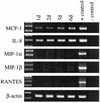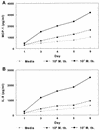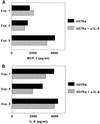Chemokine production by a human alveolar epithelial cell line in response to Mycobacterium tuberculosis
- PMID: 9488404
- PMCID: PMC108024
- DOI: 10.1128/IAI.66.3.1121-1126.1998
Chemokine production by a human alveolar epithelial cell line in response to Mycobacterium tuberculosis
Abstract
To investigate the role of chemokines during the initial local response to Mycobacterium tuberculosis in the human lung, we studied chemokine production by the human alveolar epithelial cell line A549 after infection with M. tuberculosis. M. tuberculosis-infected A549 cells produced mRNAs and protein for monocyte chemotactic protein-1 (MCP-1) and interleukin-8 (IL-8) but not mRNAs for macrophage inflammatory protein 1alpha (MIP-1alpha), MIP-1beta, and RANTES. Chemokine production in response to M. tuberculosis was not dependent on production of tumor necrosis factor alpha, IL-1beta, or IL-6. Two virulent clinical M. tuberculosis isolates, the virulent laboratory strain H37Rv, and the avirulent strain H37Ra elicited production of comparable concentrations of MCP-1 and IL-8, whereas killed M. tuberculosis and three Mycobacterium avium strains did not. The three virulent M. tuberculosis strains grew more rapidly than the avirulent M. tuberculosis strain in the alveolar epithelial cell line, and the three M. avium strains did not grow intracellularly. These findings suggest that intracellular growth is necessary for mycobacteria to elicit production of MCP-1 and IL-8 by alveolar epithelial cells but that virulence and the rate of intracellular growth do not correlate with chemokine production. Alveolar epithelial cells may contribute to the local inflammatory response in human tuberculosis by producing chemokines which attract monocytes, lymphocytes, and polymorphonuclear cells.
Figures







Similar articles
-
Chemokines induced by infection of mononuclear phagocytes with mycobacteria and present in lung alveoli during active pulmonary tuberculosis.Am J Respir Cell Mol Biol. 1998 Sep;19(3):513-21. doi: 10.1165/ajrcmb.19.3.2815. Am J Respir Cell Mol Biol. 1998. PMID: 9730880
-
Mycobacterium bovis BCG vaccination augments interleukin-8 mRNA expression and protein production in guinea pig alveolar macrophages infected with Mycobacterium tuberculosis.Infect Immun. 2002 Oct;70(10):5471-8. doi: 10.1128/IAI.70.10.5471-5478.2002. Infect Immun. 2002. PMID: 12228272 Free PMC article.
-
Chemokine receptor 5 and its ligands in the immune response to murine tuberculosis.Tuberculosis (Edinb). 2005 May;85(3):185-95. doi: 10.1016/j.tube.2004.10.003. Tuberculosis (Edinb). 2005. PMID: 15850756
-
Virulence of Mycobacterium tuberculosis affects interleukin-8, monocyte chemoattractant protein-1 and interleukin-10 production by human mononuclear phagocytes.Int J Tissue React. 2001;23(4):113-25. Int J Tissue React. 2001. PMID: 11771775
-
The efficiency of the translocation of Mycobacterium tuberculosis across a bilayer of epithelial and endothelial cells as a model of the alveolar wall is a consequence of transport within mononuclear phagocytes and invasion of alveolar epithelial cells.Infect Immun. 2002 Jan;70(1):140-6. doi: 10.1128/IAI.70.1.140-146.2002. Infect Immun. 2002. PMID: 11748175 Free PMC article.
Cited by
-
Mycobacterium tuberculosis Dissemination Plays a Critical Role in Pathogenesis.Front Cell Infect Microbiol. 2020 Feb 25;10:65. doi: 10.3389/fcimb.2020.00065. eCollection 2020. Front Cell Infect Microbiol. 2020. PMID: 32161724 Free PMC article. Review.
-
Evaluation of the role of Mycobacterium tuberculosis pili (MTP) as an adhesin, invasin, and cytokine inducer of epithelial cells.Braz J Infect Dis. 2016 Mar-Apr;20(2):160-5. doi: 10.1016/j.bjid.2015.11.002. Epub 2015 Dec 31. Braz J Infect Dis. 2016. PMID: 26748229 Free PMC article.
-
Heparin-binding Hemagglutinin of Mycobacterium tuberculosis Is an Inhibitor of Autophagy.Front Cell Infect Microbiol. 2017 Feb 7;7:33. doi: 10.3389/fcimb.2017.00033. eCollection 2017. Front Cell Infect Microbiol. 2017. PMID: 28224118 Free PMC article.
-
Changes in gene expression in macrophages infected with Mycobacterium tuberculosis: a combined transcriptomic and proteomic approach.Immunology. 2001 Sep;104(1):99-108. doi: 10.1046/j.0019-2805.2001.01274.x. Immunology. 2001. PMID: 11576227 Free PMC article.
-
Potential role for ESAT6 in dissemination of M. tuberculosis via human lung epithelial cells.Mol Microbiol. 2010 Jan;75(1):92-106. doi: 10.1111/j.1365-2958.2009.06959.x. Epub 2009 Nov 10. Mol Microbiol. 2010. PMID: 19906174 Free PMC article.
References
-
- Antony V B, Godbey S W, Kunkel S L, Hott J W, Hartman D L, Burdick M D, Strieter R M. Recruitment of inflammatory cells to the pleural space. Chemotactic cytokines, IL-8, and monocyte chemotactic peptide-1 in human pleural fluids. J Immunol. 1993;151:7216–7223. - PubMed
-
- Barnes P F, Chatterjee D, Abrams J S, Lu S, Wang E, Yamamura M, Brennan P J, Modlin R L. Cytokine production induced by Mycobacterium tuberculosis lipoarabinomannan. Relationship to chemical structure. J Immunol. 1992;149:541–547. - PubMed
Publication types
MeSH terms
Substances
Grants and funding
LinkOut - more resources
Full Text Sources
Other Literature Sources
Research Materials
Miscellaneous

